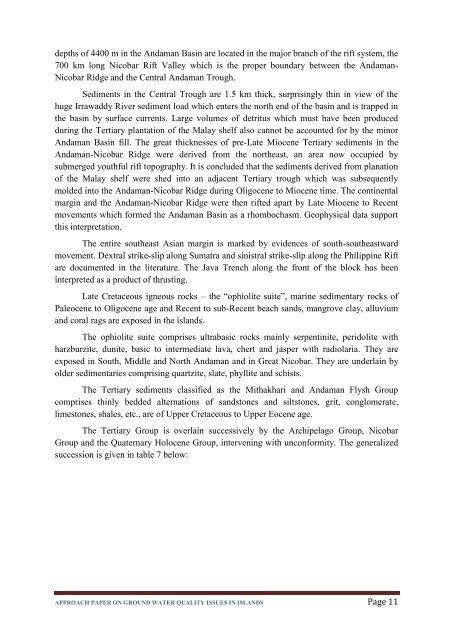approach paper on ground water quality issues in islands
approach paper on ground water quality issues in islands
approach paper on ground water quality issues in islands
You also want an ePaper? Increase the reach of your titles
YUMPU automatically turns print PDFs into web optimized ePapers that Google loves.
depths of 4400 m <strong>in</strong> the Andaman Bas<strong>in</strong> are located <strong>in</strong> the major branch of the rift system, the700 km l<strong>on</strong>g Nicobar Rift Valley which is the proper boundary between the Andaman-Nicobar Ridge and the Central Andaman Trough.Sediments <strong>in</strong> the Central Trough are 1.5 km thick, surpris<strong>in</strong>gly th<strong>in</strong> <strong>in</strong> view of thehuge Irrawaddy River sediment load which enters the north end of the bas<strong>in</strong> and is trapped <strong>in</strong>the bas<strong>in</strong> by surface currents. Large volumes of detritus which must have been produceddur<strong>in</strong>g the Tertiary plantati<strong>on</strong> of the Malay shelf also cannot be accounted for by the m<strong>in</strong>orAndaman Bas<strong>in</strong> fill. The great thicknesses of pre-Late Miocene Tertiary sediments <strong>in</strong> theAndaman-Nicobar Ridge were derived from the northeast, an area now occupied bysubmerged youthful rift topography. It is c<strong>on</strong>cluded that the sediments derived from planati<strong>on</strong>of the Malay shelf were shed <strong>in</strong>to an adjacent Tertiary trough which was subsequentlymolded <strong>in</strong>to the Andaman-Nicobar Ridge dur<strong>in</strong>g Oligocene to Miocene time. The c<strong>on</strong>t<strong>in</strong>entalmarg<strong>in</strong> and the Andaman-Nicobar Ridge were then rifted apart by Late Miocene to Recentmovements which formed the Andaman Bas<strong>in</strong> as a rhombochasm. Geophysical data supportthis <strong>in</strong>terpretati<strong>on</strong>.The entire southeast Asian marg<strong>in</strong> is marked by evidences of south-southeastwardmovement. Dextral strike-slip al<strong>on</strong>g Sumatra and s<strong>in</strong>istral strike-slip al<strong>on</strong>g the Philipp<strong>in</strong>e Riftare documented <strong>in</strong> the literature. The Java Trench al<strong>on</strong>g the fr<strong>on</strong>t of the block has been<strong>in</strong>terpreted as a product of thrust<strong>in</strong>g.Late Cretaceous igneous rocks – the “ophiolite suite”, mar<strong>in</strong>e sedimentary rocks ofPaleocene to Oligocene age and Recent to sub-Recent beach sands, mangrove clay, alluviumand coral rags are exposed <strong>in</strong> the <strong>islands</strong>.The ophiolite suite comprises ultrabasic rocks ma<strong>in</strong>ly serpent<strong>in</strong>ite, peridolite withharzburzite, dunite, basic to <strong>in</strong>termediate lava, chert and jasper with radiolaria. They areexposed <strong>in</strong> South, Middle and North Andaman and <strong>in</strong> Great Nicobar. They are underla<strong>in</strong> byolder sedimentaries compris<strong>in</strong>g quartzite, slate, phyllite and schists.The Tertiary sediments classified as the Mithakhari and Andaman Flysh Groupcomprises th<strong>in</strong>ly bedded alternati<strong>on</strong>s of sandst<strong>on</strong>es and siltst<strong>on</strong>es, grit, c<strong>on</strong>glomerate,limest<strong>on</strong>es, shales, etc., are of Upper Cretaceous to Upper Eocene age.The Tertiary Group is overla<strong>in</strong> successively by the Archipelago Group, NicobarGroup and the Quaternary Holocene Group, <strong>in</strong>terven<strong>in</strong>g with unc<strong>on</strong>formity. The generalizedsuccessi<strong>on</strong> is given <strong>in</strong> table 7 below:APPROACH PAPER ON GROUND WATER QUALITY ISSUES IN ISLANDS Page 11


